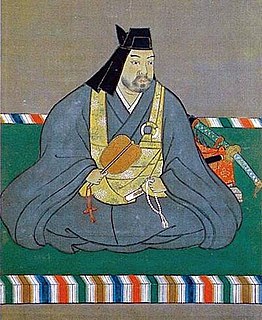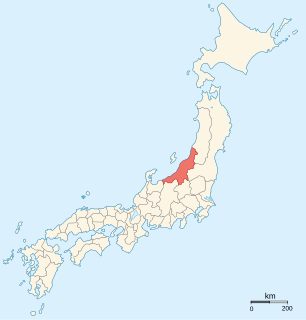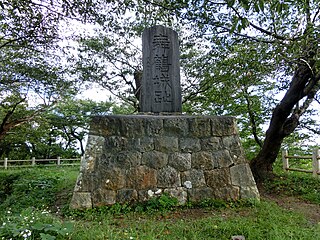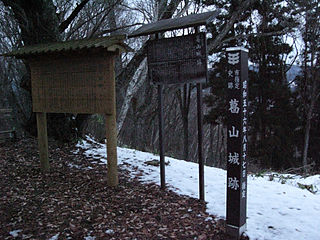
Niigata Prefecture is a prefecture in the Chūbu region of Honshu of Japan. Niigata Prefecture has a population of 2,227,496 and is the fifth-largest prefecture of Japan by geographic area at 12,584.18 km2 (4,858.78 sq mi). Niigata Prefecture borders Toyama Prefecture and Nagano Prefecture to the southwest, Gunma Prefecture to the south, Fukushima Prefecture to the east, and Yamagata Prefecture to the northeast.

Uesugi Kenshin was a daimyō who was born as Nagao Kagetora of the Nagao clan, and after adoption into the Uesugi clan, ruled Echigo Province in the Sengoku period of Japan. He was one of the most powerful daimyōs of the Sengoku period. Known as the "Dragon of Echigo", while chiefly remembered for his prowess on the battlefield, Kenshin is also regarded as an extremely skillful administrator who fostered the growth of local industries and trade and his rule saw a marked rise in the standard of living of Echigo.

Sanada Masayuki was a Japanese Sengoku period lord and daimyō. He was the head of Sanada clan, a regional house of Shinano Province, which became a vassal of the Takeda clan of Kai Province.

Shibata Katsuie or Gonroku (権六) was a Japanese samurai and military commander during the Sengoku period. He served Oda Nobunaga as one of his trusted generals, was severely wounded in the 1571 first siege of Nagashima, but then fought in the 1575 Battle of Nagashino and 1577 Battle of Tedorigawa.
The Battle of Tedorigawa took place near the Tedori River in Japan's Kaga Province in 1577, between the forces of Oda Nobunaga against Uesugi Kenshin. Kenshin tricked Nobunaga into launching a frontal attack across the Tedorigawa and defeated him. Having suffered the loss of 1,000 men, the Oda withdrew south. This was destined to be Kenshin's last great battle. The battle site is in the modern-day Ishikawa Prefecture.

Etchū Province was a province of Japan in the area that is today Toyama Prefecture in the Hokuriku region of Japan. Etchū bordered on Noto and Kaga Provinces to the west, Shinano and Hida Provinces to the south, Echigo Province to the east and the Sea of Japan to the north. Its abbreviated form name was Esshū (越州).

Echigo Province was an old province in north-central Japan, on the shores of the Sea of Japan. It bordered on Uzen, Iwashiro, Kōzuke, Shinano, and Etchū Provinces. It corresponds today to Niigata Prefecture, minus the island of Sado.

Uesugi Kagekatsu was a Japanese samurai daimyō during the Sengoku and Edo periods. He was the adopted son of Uesugi Kenshin and Uesugi Kagetora’s brother in law.

Nagao clan was a Japanese samurai clan.

Uesugi Norimasa was a daimyō of feudal Japan from Yamanouchi branch Uesugi clan and held the post of Kantō Kanrei, the shōgun's deputy in the Kantō region. He was the adoptive father of Uesugi Kenshin, one of the most famous warlords in Japanese history.

Sassa Narimasa, also known as Kura-no-suke (内蔵助), was a Japanese samurai of the Sengoku through Azuchi–Momoyama period. He entered Nobunaga's service at the age of 14 and remained in his lord's service throughout Nobunaga's rise to power. He was a member of the so-called Sanninshu along with Maeda Toshiie and Fuwa Mitsuharu.

Kaminoyama Domain a feudal domain in Edo period Japan, located in Dewa Province, Japan. It was centered on Kaminoyama Castle in what is now the city of Kaminoyama, Yamagata.

Shibata Castle is a flatland-style Japanese castle located in the city of Shibata, Niigata Prefecture, Japan. Throughout the Edo period, Shibata Castle was home to the Mizoguchi clan, daimyō of Shibata Domain. The castle was also known as "Ayame-jō".

Shibata Domain was a tozama feudal domain under the Tokugawa shogunate of Edo period Japan. It is located in Echigo Province, Honshū. The domain was centered at Shibata Castle, located in what is now the city of Shibata in Niigata Prefecture. It was ruled for all of its history by the Mizoguchi clan.

Matsukura Castle was a Muromachi period yamajiro-style Japanese castle located in what is now the city of Uozu, Toyama Prefecture, in the Hokuriku region of Japan. It was one of the three major mountain-castles in Etchū Province, along with Matsuyama Castle in central Etchū and Moriyama Castle in western Etchū.

Murakami Castle is a Japanese castle located in Murakami, northern Niigata Prefecture, Japan. At the end of the Edo period, Murakami Castle was home to a cadet branch of the Naitō clan, daimyō of Murakami Domain under the Tokugawa shogunate. The castle was also known as "Maizuru-jō" (舞鶴城). The ruin been protected as a National Historic Site since 1993. It is about 30 minutes on foot from Murakami Station on the JR East Uetsu Line.

The Siege of Katsurayama in March 1557 was fought between the forces of the Japanese daimyō Takeda Shingen and Uesugi Kenshin as part of the Kawanakajima campaigns. Katsurayama castle was a strategically vital Uesugi stronghold in the contested Shinano Province and, when it was isolated from reinforcements due to late snow in early 1557, the Takeda clan used this opportunity to attack it. Although the castle garrison, consisting of the Ochiai clan and elements of the Murakami clan, defended Katsurayama furiously, the Takeda forces under Baba Nobuharu eventually stormed into the castle. Most of the garrison was killed in combat, while the families of the defenders committed mass suicide and the castle was burned to the ground.

Masuyama Castle was a Muromachi period yamashiro-style Japanese castle located in what is now part of the city of Tonami, Toyama Prefecture in the Hokuriku region of Honshu, Japan. The ruins have been protected by the central government as a National Historic Site since 2009. It was also known as Wada Castle

Mizoguchi Nobukatsu was a Sengoku period samurai and the 2nd daimyō of Shibata Domain in early Edo period Echigo Province, Japan. His courtesy title was Hōki-no-kami, and his Court rank was Junior Fifth Rank, Lower Grade.
Oguni Castle was a Nanboku-chō period yamashiro-style Japanese castle located in what is now part of the city of Tsuruoka, Yamagata Prefecture in the Tōhoku region of northern Japan. The site has been protected by the central government as a National Historic Site since 2002. The site is approximately 30 minutes by car from Atsumi Onsen Station on the JR East Uetsu Main Line. It should not be confused with another Oguni Castle in Dewa Province, located in the Mogami region.

















